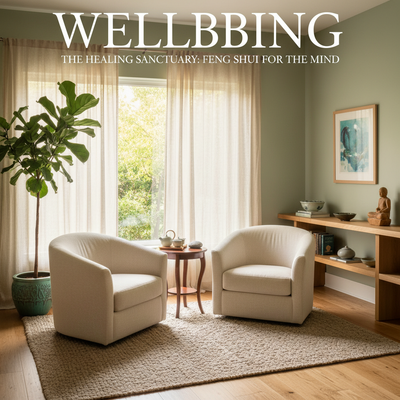Introduction
A bedroom should be a safe place, a personal space for rest and getting your energy back. But what happens when you share it with someone else? When two people's energies, belongings, and different personalities come together, it can easily create mess instead of calm. Whether you're sharing with a romantic partner, a brother or sister, or a roommate, the challenge is the same: how do we create a space that feels peaceful and helpful for everyone?
This is where the ancient practice of feng shui becomes a very useful tool. It offers more than just decorating tips; it gives you a strong system for creating energy balance and harmony, especially when sharing a space. This guide is your roadmap. We will walk you through basic ideas, give you specific solutions for your living situation, and offer a practical plan for making these changes together. A peaceful, balanced feng shui shared bedroom is not just a dream; it's something you can really achieve.
Basic Bedroom Feng Shui

Before we talk about the challenges of a shared space, we need to understand the basic feng shui rules that work for any bedroom. These form the foundation of a restful space. Learning these basics helps you make small but very powerful changes, creating a solid base for harmony. We'll explain each idea clearly, focusing on the "why" behind each rule to help you understand better.
The Commanding Position
This is the most important rule for creating a sense of safety and helping you get deep, refreshing rest. The commanding position means you can see the bedroom door from your bed, but you are not directly in line with it. Your bed should be placed diagonally across from the door. This setup connects to a basic human need for safety and awareness. When you can see who or what is coming into your space without thinking about it, your nervous system can relax, allowing for better sleep and reducing hidden worry. For both people in the room, this feeling of safety is the first step toward a calm space.
The Power of Cleaning Up
Clutter is more than just physical mess; in feng shui, it represents stuck energy, or Qi. Piles of clothes, stacks of books, and general messiness block the flow of positive energy, leading to feelings of being stuck, overwhelmed, or tired. In a feng shui shared bedroom, cleaning up is an important shared job. It's an agreement to keep a clear space not just because it looks good, but for the energy health of the room and the people in it. Clearing physical clutter directly helps clear mental and energy blocks, making way for peace and clarity.
Balancing Yin and Yang
Every space is a mix of two opposite but connected forces: Yin and Yang. Yin energy is quiet, dark, soft, and calm—the energy of rest. Yang energy is bright, active, hard, and expressive—the energy of daytime activity. A bedroom's main purpose is rest, so it should be mostly Yin. This is done through soft lighting, calming colors, comfortable fabrics, and sound-reducing materials like curtains and rugs. However, a room that is too Yin can feel stuck or sad. Small touches of Yang, like a metal picture frame or a single bright pillow, are needed to create balance and prevent laziness.
A Look at Five Elements
The Five Elements—Wood, Fire, Earth, Metal, and Water—are the building blocks of feng shui. A balanced room includes parts of each. Understanding their role helps you fine-tune your bedroom's atmosphere.
- Wood: Represents growth, healing, and life. We can bring it in with healthy plants (use carefully in a bedroom), wooden furniture, or shades of green and brown.
- Fire: Symbolizes passion, energy, and expression. Use this element very carefully in a bedroom. Small touches like a candle (used safely) or accents in red, orange, or purple are enough. Too much Fire can lead to arguments and restlessness.
- Earth: Provides stability, nourishment, and support. This is a very important element for a bedroom. We bring it in with earth tones like beige, sand, and terracotta, as well as square shapes and ceramic objects.
- Metal: Helps with clarity, precision, and focus. It's connected with colors like white, grey, and metallics, as well as round or oval shapes. Metal frames or light fixtures are great examples.
- Water: Connected to emotion, intuition, and flow. We can include it through wavy patterns, mirrors (used carefully), and colors like black or dark blue. It's best to avoid actual water features like fountains, as they can bring worry energy into a sleep space.
The Shared Room Challenge
Using feng shui in your own space is one thing; working it out with another person is where the real work begins. A shared bedroom presents special challenges that go beyond simple furniture placement. Recognizing these specific problems is the first step toward finding a balanced solution. These challenges are not impossible problems but chances to create a deeper level of balance.
Competing Energies and Tastes
Each person has a unique energy pattern and personal taste. One person may do well in a simple, sparse space (Metal and Water energy), finding it calming and clear. Their partner might need a cozy, vibrant space filled with personal items and warm colors (Wood and Earth energy) to feel secure. When these energies and style preferences clash, the room can feel disconnected and become a source of unspoken tension. The goal of feng shui in this situation is not to say one style is "right," but to skillfully blend these different needs into a unified whole.
The Compromise Problem
How do you define "yours, mine, and ours" within four walls? This is the compromise problem. It affects everything from closet space to which side of the bed one sleeps on. We've seen it many times in our work: one person needs complete darkness to sleep (strong Yin energy), while their partner feels worried without a nightlight (a touch of Yang). Feng shui teaches us not to fight this, but to find a balanced solution. Instead of arguing, we can add a dimmable, warm-toned Himalayan salt lamp. It provides a gentle, non-disturbing glow that satisfies the need for a light source without disrupting the calm, Yin energy needed for deep sleep for both people.
Custom Feng Shui Solutions
The specific dynamics of your relationship determine the best feng shui approach. A room shared by a couple has different energy needs than one shared by siblings or roommates. Here are concrete, actionable solutions you can apply directly to your living situation to create the right kind of harmony.
For Couples: Building Romance
A couple's bedroom should be a sanctuary for the partnership, supporting closeness, connection, and rest.
- Focus on Symmetry. This is the most powerful feng shui tool for a couple. Matching nightstands, matching lamps, and an equal number of pillows on each side of the bed symbolize balance and equality in the relationship. It's also important that both partners have equal, easy access to get in and out of bed, without one person being trapped against a wall.
- Activate the Relationship Corner. From the bedroom door, the far-right corner of the room is the Kun area, which governs love and relationships. Gently enhance this area to support your partnership. Place items in pairs, such as two pink candles, two rose quartz crystals, or a meaningful photo of the two of you. This strengthens the energy of "two" and "us."
- What to Remove. Just as important is what you take out. To protect romantic energy, remove photos of family, children, or friends; the bedroom is for the couple's energy alone. All work-related items, including laptops and paperwork, must go. Exercise equipment, with its active Yang energy, also creates an atmosphere of work and stress, not rest and connection.
For Siblings: Creating Harmony
For children or siblings sharing a room, the goal is to create mutual respect while also supporting each child's individual growth and identity.
- Create Separate Zones. Give each child a sense of their own territory. This doesn't require a physical wall. Use different colored rugs, distinct bedding, or even a central bookshelf to act as a subtle, respectful divider. This gives each child a sense of personal space and ownership, reducing fights.
- Bed Placement for Harmony. If possible, avoid bunk beds. From a feng shui perspective, the person on the bottom bunk can feel energetically "crushed" or held down, while the person on top can feel ungrounded. If space limits make them necessary, ensure the top bunk is solid and well-built, and that the bottom bunk has good, independent lighting. The ideal layout is two beds placed side-by-side with a shared nightstand in between.
- Support Their Individual Needs. You can use feng shui to support their individual activities. If possible, try to place each child's study desk in their respective "Knowledge" corner (the near-left corner of their personal zone, as viewed from the entrance to their zone). This helps anchor the energy of learning and growth in their personal space.
For Roommates: Encouraging Respect
When sharing with a roommate, the primary feng shui goals are mutual respect, clear boundaries, and peaceful coexistence. The energy should be neutral and calm.
- Boundaries are Everything. If schedules differ, or if you simply need a sense of privacy, physical dividers are excellent tools. A folding screen or a ceiling-mounted curtain can create a respectful physical and energy boundary. This simple act can prevent a great deal of conflict by allowing each person to control their own light and sense of privacy.
- Aim for Neutrality. The best approach for shared decor is to agree on a neutral base color scheme. Colors like soft greys, whites, and earthy beiges create a calm, non-confrontational backdrop. Each roommate can then express their personality through their own bedding, artwork within their designated space, and small personal decor items. This prevents one person's style from taking over the entire room.

- The Clutter Agreement. In a roommate situation, clutter from one person directly affects the other. Frame decluttering not as a matter of tidiness, but as a non-negotiable agreement of mutual respect. Agree on ground rules: floors must be kept clear, and shared surfaces should remain uncluttered. This maintains a healthy flow of Qi for the entire room.
A Guide to Compromise
Knowing the "what" of feng shui is only half the battle. The "how"—implementing these changes with another person—is often the biggest hurdle. Resistance, differing opinions, and attachment to old habits can ruin even the best intentions. We've developed a simple communication system to make this process collaborative and successful.
Step 1: Find a Shared "Why"
Before you mention moving a single piece of furniture, start a conversation about a common goal. Don't lead with feng shui. Lead with the desired outcome. You might say, "I've been feeling so tired lately, I really want us to figure out how to get better sleep," or "This room feels a bit stressful and cluttered, what if we tried to make it more relaxing?" By agreeing on a shared "why," you transform the project from "my idea" into "our goal."
Step 2: Introduce Feng Shui Neutrally
Once you have a shared goal, you can introduce feng shui as a neutral, third-party problem-solver. Frame it as a helpful system you discovered, not as your personal preference. Instead of saying, "I want to move the bed because it's bad feng shui," try a softer approach: "I was reading about how bed placement can affect sleep, and there's this feng shui idea called the 'commanding position' that might help us both feel more rested. What do you think?" This makes feng shui a tool, not a demand.
Step 3: Implement One Change at a Time
Avoid overwhelming your roommate or partner with a long list of changes. Big, sweeping transformations can trigger resistance. Instead, agree to try one small, easily reversible adjustment for a week. Suggest clearing off the nightstands, or adding a pair of matching pillows. After a week, check in. "How has the room felt this week? Did you notice any difference?" This low-stakes approach builds trust and allows both people to experience the positive effects firsthand.
Step 4: Seek the "And" Solution
Often, you'll face a direct conflict of taste. This is where you must move from an "either/or" mindset to a creative "and" solution. For example: He wants his favorite band poster on the wall, and you want a serene, spa-like space. The "either/or" approach leads to a fight. The "and" solution seeks a creative compromise. Perhaps you can beautifully frame the poster and place it in a less prominent spot, like on the wall of his side of the closet, and you can then balance this with a large, calming landscape painting on the main wall opposite the bed.
The Harmony Checklist
To make this journey easier, we've put together the most critical actions into a single, easy-to-scan checklist. Use this as a quick-reference guide and a practical to-do list to start transforming your feng shui shared bedroom today.
| Area of Focus | Action Item for Harmony | Why It Matters in a Shared Space |
|---|---|---|
| The Bed | Create symmetry with matching nightstands & lamps. Ensure a solid headboard. | Symbolizes equality, balance, and stability in the relationship (for any pair). |
| Room Layout | Place the bed in the Commanding Position. Ensure a clear path to the door. | Promotes a sense of security and control for both occupants. |
| Clutter | Establish a "no-clutter" rule for floors & surfaces. Use smart, hidden storage. | Clutter represents stagnant energy and unresolved issues; keeping it clear promotes peace. |
| Decor & Art | Choose art that reflects shared goals. Use pairs of items (e.g., 2 candles). | Reinforces the energy of partnership and togetherness over individuality. |
| Technology | Create a designated charging station outside the bedroom. Keep TVs out. | The active, Yang energy of electronics disrupts the calm, Yin energy needed for rest. |
| Lighting | Use layered, dimmable lighting and warm-toned bulbs. | Allows for adjustment based on mood and the needs of each person, promoting compromise. |
Seeking Professional Guidance
While this guide provides a powerful toolkit for creating harmony, some situations have layers of complexity that a DIY approach may not fully resolve. Knowing when to seek professional guidance is a sign of wisdom, not failure. It's an investment in a deeper level of peace.
Signs You Might Need an Expert
Consider a professional consultation if you experience any of the following:
- Persistent arguments, poor sleep, or a constant feeling of unease in the room despite your best efforts.
- An inherently awkward or challenging room layout, such as a bed forced under a sloped ceiling, a room with multiple doors, or beams directly over the bed.
- A desire for a deep-dive analysis using personal birth data (Kua numbers and Four Pillars of Destiny) to tailor the environment to each individual's core elemental nature.
How a Consultation Elevates Your Space
A professional feng shui consultant goes deeper than general principles. They use specialized tools and calculations to diagnose the specific energy patterns of your home and its occupants. This often involves using a Luopan (a traditional feng shui compass) to map the precise energy sectors of the room and calculating the Kua numbers of each occupant to understand their personal best directions and elemental compatibility.
For these complex situations, a personalized consultation offers a path forward. Expert teams, such as THE QI FLOW, specialize in analyzing the unique energy interplay between occupants and the specific layout of a space. They go beyond general rules to create a tailored roadmap, addressing the root causes of disharmony and providing solutions that honor both individuals. This can be particularly transformative for a feng shui shared bedroom where the dynamics are most complex.
Your Harmonious Sanctuary
Creating a harmonious feng shui shared bedroom is ultimately an act of profound balance. It involves balancing the energy of the space with the Five Elements, balancing the decor to create a cohesive whole, and—most importantly—balancing the needs, energies, and desires of two people sharing an intimate sanctuary.
We encourage you to view this process not as a challenge to be overcome, but as a collaborative project. It's an opportunity to communicate, compromise, and build a space that truly supports and nurtures you both. Your journey to a more peaceful, harmonious shared space can begin now. Choose one small, easy change from the checklist, discuss it openly and respectfully with your partner or roommate, and take the first step together.








0 comments